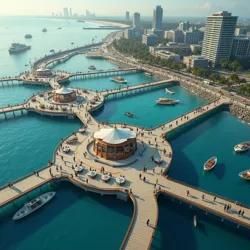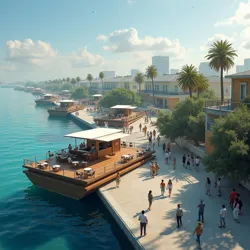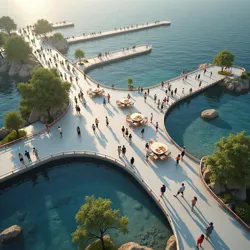The Shoreline Shuffle
Welcome to a celebration of adaptable architecture, kinetic gastronomy, and synchronized social movement in the dynamic coastal metropolis of Wavecrest Heights. Here you'll discover how a city's floating infrastructure has transformed into an ever-evolving dance between residents, restaurateurs, and the revolutionary urban planning that keeps them all in motion.
 Aerial photograph of Wavecrest Heights' signature floating boardwalks during the annual Tide & Tempo Festival, showing intricate patterns formed by synchronized movement of pedestrians
Aerial photograph of Wavecrest Heights' signature floating boardwalks during the annual Tide & Tempo Festival, showing intricate patterns formed by synchronized movement of pedestriansToday's Featured Article
The Great Promenade Pattern of 2024
The Great Promenade Pattern of 2024 marked a pivotal moment in Wavecrest Heights' evolution as a city of perpetual motion. When the devastating Northern Tidefront Storm threatened to destabilize the city's revolutionary floating infrastructure, urban planner Marina Chen orchestrated an unprecedented citywide choreography that saved the metropolitan area from potential catastrophe. The event, which required the coordinated movement of over 50,000 residents, combined the expertise of the Wavecrest Dance Collective with the innovative gastro-gravitational theories developed by celebrated chef Dominic Torres.
The preparation for this massive undertaking transformed the city's approach to communal space and movement. Chen's team worked closely with Torres to establish strategic placement of his famous Taste & Twirl dining platforms, using the weight distribution of seated diners to create anchor points throughout the floating network. Meanwhile, dance instructor Sophia Patel developed a simplified version of the Wavecrest Wave, a basic stepping pattern that allowed even inexperienced participants to contribute to the stabilizing rhythm.
In The News
The Drift Kitchen District celebrates its fifth anniversary this month with an expanded fleet of mobile dining platforms. The district's signature buoyant-flex polymer construction has proven remarkably resilient, with recent studies showing minimal wear despite constant redistribution of weight and movement. Local engineers have begun implementing new pressure-sensitive illumination systems that create visible patterns reflecting the flow of foot traffic, adding an ethereal dimension to evening dining experiences.
Momentum Plaza introduces advanced motion-mapping terminals this week, allowing residents to better predict and adapt to the city's shifting pathways. The terminals utilize data collected from thousands of daily crossings to project likely configuration changes, helping citizens plan their routes while maintaining the organic flow that characterizes Wavecrest Heights' unique urban landscape.
Did You Know...
The revolutionary buoyant-flex polymer used in Wavecrest Heights' construction was originally developed for deep-sea research vessels, designed to adapt to varying pressure levels. Its application in urban architecture was discovered accidentally when a sample was left floating in a university research pool, where it began responding to the waves created by the swimming team's practice sessions.
 Chef Dominic Torres prepares his signature tide-spiced cuisine aboard one of the original Taste & Twirl platforms
Chef Dominic Torres prepares his signature tide-spiced cuisine aboard one of the original Taste & Twirl platformsMovement Arts & Culinary Innovation
The Wavecrest Dance Collective continues to expand its influence beyond traditional performance spaces. Their latest initiative, the Kinetic Commerce Program, trains local vendors in movement patterns that optimize their mobile businesses' integration with the city's flow. Small business owners learn to position their floating shops at natural gathering points created by the boardwalk's daily rhythms.
Recent developments in gastro-gravitational theory have led to the establishment of specialized dining zones where the combined effect of coordinated service patterns and customer movement creates stable "islands" within the shifting cityscape. These innovations have inspired a new generation of mobile restaurateurs who design their menus and service styles to complement specific movement patterns.
Urban Planning & Infrastructure
The success of Wavecrest Heights' adaptive infrastructure has drawn attention from coastal cities worldwide. The Municipal Motion Bureau regularly hosts international delegations studying the city's unique approach to urban flexibility. Of particular interest is the Tidal Response Network, a system of sensors and automated adjustment mechanisms that helps maintain stability during periods of intense maritime activity.
Research continues into the relationship between pedestrian behavior and infrastructure movement, with the recent establishment of the Pattern Recognition Institute. The institute's primary focus is developing predictive models for the city's movement cycles, working to balance the spontaneous nature of the floating segments with residents' need for reliable transportation routes.
Community & Education
The Wavecrest Navigation Academy has become an essential part of city life, offering courses in everything from basic boardwalk traversal to advanced movement choreography. New residents participate in mandatory orientation sessions, learning to read the subtle cues that indicate imminent platform shifts and understanding how their own movement contributes to the city's larger patterns.
 Residents participating in a morning promenade practice session at Momentum Plaza
Residents participating in a morning promenade practice session at Momentum PlazaFeatured Locations
Drift Kitchen District
The heart of Wavecrest Heights' floating culinary scene encompasses over thirty independently mobile restaurant platforms. These establishments range from intimate cafes to expansive dining halls, each contributing uniquely to the district's perpetual dance of service and consumption. The district's movement patterns are carefully orchestrated to create natural gathering spaces while maintaining efficient traffic flow between venues.
Momentum Plaza
Serving as both a central transportation hub and community gathering space, Momentum Plaza demonstrates the perfect synthesis of necessity and artistry that characterizes Wavecrest Heights. The plaza's sophisticated movement patterns incorporate both planned transitions for peak traffic hours and spontaneous reconfigurations that respond to unexpected crowd formations. Daily promenade practices here help residents maintain their movement literacy while contributing to the plaza's essential stability.
Today's Featured Movement Pattern
The Shoreline Spiral, developed by Sophia Patel in collaboration with the Wavecrest Dance Collective, has been designated as today's recommended traversal pattern. This flowing sequence of steps helps maintain optimal platform distribution during high-tide periods while creating natural pauses at key intersection points. Residents are encouraged to incorporate this pattern into their daily commutes, particularly when crossing the following zones:
-
The Northern Archipelago District
-
The Central Flow Corridor
-
The Maritime Market Loop
Current Infrastructure Status
The Municipal Motion Bureau reports all major thoroughfares are operating within standard movement parameters. Minor adjustments are ongoing in the Eastern Harbor Section due to scheduled maintenance of several buoyant-flex polymer anchor points. Residents are advised to allow extra time when traveling through this area and to maintain awareness of their contribution to collective movement patterns.
The Tidal Forecast Office predicts moderate platform activity for the upcoming week, with potential for increased movement during evening peak hours. Visitors to the Drift Kitchen District are reminded that dinner service hours have been adjusted to optimize weight distribution during sunset, when thermal changes typically cause slight shifts in platform buoyancy.
Upcoming Events
The annual Tide & Tempo Festival approaches, promising ten days of coordinated celebrations across Wavecrest Heights' floating network. This year's festival features an unprecedented collaboration between the Wavecrest Dance Collective and the city's leading culinary artists, culminating in a synchronized dining experience spanning the entire Drift Kitchen District.
Preparations are underway for the season's first Mass Movement Meditation, where thousands of residents will participate in a choreographed walking pattern designed to generate gentle, rolling waves throughout the city's connected platforms. This event, led by movement specialist Elena Rivera, demonstrates the remarkable potential of coordinated human activity to influence urban infrastructure.
Research & Development
The Pattern Recognition Institute continues its groundbreaking work on the relationship between collective movement and infrastructure stability. Recent findings suggest that spontaneous synchronization among pedestrians may contribute more significantly to platform stability than previously believed. This research has led to the development of new rhythmic guidance systems being tested in high-traffic areas.
Advances in buoyant-flex polymer technology have enabled the creation of more responsive platform sections, capable of adapting to subtle changes in weight distribution and movement patterns. These improvements have expanded the potential for creative configuration while maintaining the structural integrity essential to the city's unique urban design.
The successful integration of movement arts and urban planning in Wavecrest Heights has inspired a new field of study dubbed Kinetic Urban Theory. This emerging discipline examines how cities might evolve when infrastructure is treated not as a static framework but as a dynamic participant in daily life. The theory has particularly significant implications for coastal communities facing increasing environmental pressures.